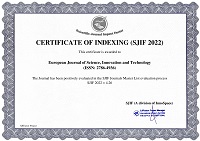Support Vector Machine-Based Model for the Classification of Effective Antibiotic Combination for Pediatrics: A Comparative Analysis of Pre-COVID-19 and COVID-19 Era
Abstract
The COVID-19 virus is suspected to have introduced a different layer of resistance to antibiotics for pediatric patients. Traditional methods for selecting antibiotics often yield suboptimal results due to their inability to adapt to evolving patterns of microbial culture and sensitivity. Therefore, to provide a more precise and individualized approach to selecting antibiotics and ascertaining their effectiveness before and after the onset of the pandemic, it is necessary to leverage the power of Artificial Intelligence. In this study, the Support Vector Machine (SVM), a machine learning algorithm, is proposed. The model trained on extensive datasets of microbial responses and different antibiotic combinations was designed and implemented. Findings revealed that the model outperforms conventional techniques with an accuracy of 83% and 89% respectively for the pre-COVID-19 and COVID-19 era in predicting effective antibiotic combinations. More importantly, the results showed that 75.6% of drugs in our dataset were effective before COVID-19 while 72.9 % were effective after the pandemic, indicating that more antibiotic drugs were effective before COVID-19 than afterward. Results also indicated an increase in resistance to antibiotics and antibiotics combination after the onset of COVID-19, substantiating the suspicion that COVID-19 has a significant negative impact on the effectiveness of antibiotic therapy in pediatric patients.
References
Andrews, A., Bou-Antoun, S., Guy, R., Brown, C. S., Hopkins, S., & Gerver, S. (2022). Respiratory antibacterial prescribing in primary care and the COVID-19 pandemic in England, winter season 2020–21. Journal of Antimicrobial Chemotherapy, 77(3), 799-802.
Ekong, A. (2023). Evaluation of machine learning techniques towards early detection of cardiovascular diseases. American Journal of Artificial Intelligence, 7(1), 6-16.
Ekong, A., Attih, I., James, G., & Edet, U. (2024). Effective classification of diabetes mellitus using support vector machine algorithm. Researchers Journal of Science and Technology, 4(2), 18-34.
Ekong, A., Etuk, A., Inyang, S., & Ekere-Obong, M. (2023). Securing Against Zero-Day Attacks: A Machine Learning Approach for Classification and Organizations’ Perception of its Impact. Journal of Information Systems and Informatics, 5(3), 1123-1140.
Ekong, A., James, G., Ekpe, G., Edet, A., & Dominic, E. A. (2024). Model for the Classification of Bladder State Based on Bayesian Network. International Journal of Engineering and Artificial Intelligence, 5(2), 33-47.
Ekong, A., Odikwa, H., & Ekong, O. (2021). Minimizing Symptom-based Diagnostic Errors Using Weighted Input Variables and Fuzzy Logic Rules in Clinical Decision Support Systems. International Journal of Advanced Trends in Computer Science and Engineering, 10(3), 1567 – 1575.
Eyad, E., Amir, H., Aziz, S., Abdelraouf, A., Pattaramon, V., & Karolin, H. (2020). Antimicrobial resistance and machine learning: challenges and opportunities. IEEE, 10(1).
Gajic, I., Kabic, J., Kekic, D., Jovicevic, M., Milenkovic, M., Mitic Culafific, D., Trudic, A., Ranin, l., & Opavski, N. (2022). Antimicrobial Susceptibility Testing: a Comprehensive Review of Currently Used Methods. Antibiotics, 11(4).
Georgios, F., Evangelos, L., Aikaterini, S., Dimitris, K., Malvina, L., & Constantinos, C. (2020). Using machine learning algorithms to predict antimicrobial resistance and assist empirical treatment. Studies in health technology and informatics, 272, 75-78.
Hui, P., Ping, G., Qiong, X., Maochang, L., Jing, P., Yang, W., & Hua, X. (2020). Coronavirus disease 2019 in children: Characteristics, antimicrobial treatment, and outcomes. Journal of Clinical Virology, 128.
James, G. G., Asuquo, J. E., Etim, E. O. & Michael, N. A. (2023). Adaptive Predictive Model for Post-COVID-19 Health Care Assistive Medication Adherence System, Contemporary Discourse on Nigeria’s Economic Profile, A Festschrift in Honour of Professor Nyaudoh Ukpabio Ndaeyo, (2023), Vice-Chancellor University of Uyo, Nigeria.
James, G. G., Ekpo, W. F., Chukwu, E. G., Michael, N. A., Ebong, O. A., & Okafor, P. C. (2024). Optimizing Business Intelligence System Using Big Data and Machine Learning. J. Inf. Syst. Inform., 6(1). http://journal-isi.org/index php/isi.
James, G., Ekong, A., Abraham, E., Oduobuk, E., & Okafor, P. (2024). Analysis of support vector machine and random forest models for predicting the scalability of a broadband network.
Lewin-Epstein, O., Baruch, S., Hadany, L., Stein, G., & Obolski, U. (2021). Predicting antibiotic resistance in hospitalized patients by applying machine learning to electronic medical records. Clin Infect Dis, 2(11), 848-855.
Moran, E., Robinson, E., Green, C., Keeling, M., & Collyer, B. (2020). Towards personalized guidelines: using machine-learning algorithms to guide antimicrobial selection. Journal of Antimicrobial Chemotherapy, 75(9), 2677-2680.
Moses, E., Edoho, M., Udo Ifiok, Etebong, P., Uto Nseobong, Jackson, T., & Obiakor, N. (2021). A transfer learning approach to drug resistance classification in mixed HIV dataset. Informatics in Medicine Unlocked, 24(2021).
Mustafa, K. P., Syed, F. A. A., Fariha, I., Asma, T. Q., & Rabia, A. (2021). Identification of efficient COVID-19 diagnostic test through Artificial Neural Networks approach − substantiated by modeling and simulation. Journal of Intelligent Systems, 30(1), 836-854.
Sanjay, K., Hyewon, J., Yidan, M., Alex, W., Kexin, Y., & David, S. (2022). Estimating the impact of antibiotic exposure on antibiotic resistance in uncomplicated UTI using machine learning causal inference. Open Forum Infectious Diseases, 9(2).
Snehal, G., Sreemoyee, C., Sharma, A., Vijay, S. et al. (2023). Determination of antibiotic resistance level in klebsiella using machine learning models. Proceedings of Seventh International Congress on information and communication technology.
Sohail, M. N., Muhammad, Z., Jehangir, A., Melkamu, D. A., Muhammad, S., Yumeng, Y., Mi, Z., Xin, L., Qingdong, X., & Xiaoyang, J. (2023). Machine learning techniques for antimicrobial resistance prediction of pseudomonas aeruginosa from whole genome sequence data. Computational Intelligence and Neuroscience, 2023(1).
Ting, Y., FuJintao, H., Jintao, H., Jun, Z., Yunlei, X., & Yunlei, X. (2023). Identification of antibiotic resistance in eskape pathogens through plasmonic nanosensors and machine learning. ACS Nano, 17(5).
Yuepeng, S., Bertrand, C., Jennifer, C., & Xu, L. (2021). Predicting antibiotic resistance gene abundance in activated sludge using shotgun metagenomics and machine learning. Water Research, 202(1), 117384.
Copyright (c) 2025 Anietie Ekong, Gabriel James, Godwin Ekpe, Idara James, Otuekong Ekong, Blessing Ekong, Anthony Edet, Edikan Okon

This work is licensed under a Creative Commons Attribution 4.0 International License.


 ISSN
ISSN 











